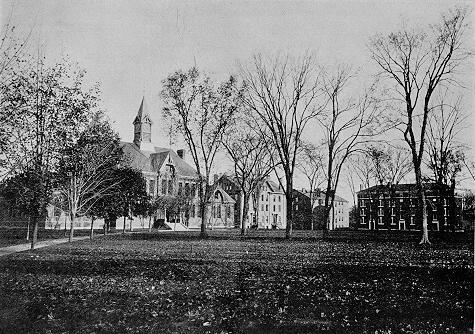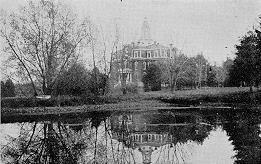By D. Fisher — 1900
Back to previous section — Forward to next section — Return to Table of Contents
CHAPTER 3
First Settlement of Exeter
The Rev. John Wheelwright was a graduate of Cambridge University, England, a fellow-collegian and life-long friend of Oliver Cromwell, and a learned, devout, and courageous preacher. He married as a second wife, Mary, a sister of the celebrated Anne Hutchinson, and soon after joined the Massachusetts colony, landing in Boston May 26, 1636.
He soon became implicated in the Hutchinson theological controversy. Tried by the general court of the colony in November, 1637, he was sentenced to disfranchisement and banishment, and given two weeks’ time to leave the colony. For some reason he did not go to Rhode Island with the Hutchinsons, but turned his steps eastward.
It is supposed that he passed the winter with Edward Hilton in the vicinity of Dover. In April, 1638, he purchased a large tract of land from the Indians.
The description of this tract in the deed says that it comprises, “All those Landes woods medowes marshes rivers brookes springs with all the appurtenances, emoluments to fitto comoditys there unto belonging lying and situate within three miles of the northern side of ye river Meremake extending thirty miles along sayd river from ye sea side & from ye sayd side to Pischataqua Patents thirty miles into the country northwest & soe from the falls of Pischataqua to Oyster river thirty miles square everyway to have & to hould the same to theire and ye heyers for ever,” &c.
In March, 1638, Wheelwright’s family left Boston to join him. The falls in the Squamscott (Exeter) river had been selected as the site of the new town. Settlers began to arrive and by autumn some twenty families had gathered there.
It was a religious colonization in every sense. By the end of the second year the colony had doubled in number. A complete and independent government was organized. In the second year of the settlement lands were allotted. In 1640 there were nearly two hundred people in the new town.
Massachusetts did not long leave the Exeter colony in peace. She had sent men to build a house at Hampton as early as 1636 so as to establish a legal title to the marshes there. In those days marshes producing hay were valuable. Later she extended her jurisdiction over the settlements at Dover and Portsmouth. The settlers there, oppressed by fears of coming troubles with the Indians, desired the powerful aid of Massachusetts. Being thus surrounded, and perhaps divided in sentiment, in 1643, Exeter acknowledged the jurisdiction of the Bay colony.
Wheelright was still under the decree of banishment, and with a few faithful adherents he moved to Wells, Me. Such was the origin of Exeter and the end of Wheelright’s connection with it. Settlers in larger numbers came from Massachusetts. In 1644 three citizens were elected to take charge of town affairs. They were Exeter’s first selectmen.
The people of New Hampshire were never quite satisfied with Massachusetts rule. Their continued efforts, combined with the influence of the heirs of Gorges and Mason, who held large grants of land from the crown, culminated in the establishment of the independent colony of New Hampshire in 1680. By this time Portsmouth and Exeter were the leading towns of the new colony.
When Wheelwright was forced to leave Exeter, the new settlement for a long time was without a pastor. In May, 1644, Massachusetts revoked the decree of banishment against Wheelwright, and Exeter promptly opened the door to his return. For some reason he did not accept the offer. In May, 1650, Samuel Dudley, son of Governor Thomas Dudley of Massachusetts and son-in-law to John Winthrop, was engaged to assume charge of the church in Exeter. Thus began a pastorate of the greatest influence on the future of the town, which lasted to the close of Dudley’s life, in 1683.
Not until 1744 did anything occur to seriously interrupt the easy way of the established First church. Under the influence of the wonderfully eloquent preaching of the celebrated Rev. George Whitefield, of English and American fame, a large number withdrew from the First church and established what is now known as the Second, or Phillips, church. The Rev. John Odlin, of the established First church, met Whitefield on the border of the town and solemnly warned him not to trespass on his (Odlin’s) parochial charge.
For some years the new society had no settled pastor, but in 1747, Rev. Samuel Rogers was formally chosen. His pastorate ended with his death in 1785, a period of thirty-eight years. He was the seventh in direct descent from Rev. John Rogers, burned at Smithfield, England, in February, 1555, the first martyr of bloody Queen Mary’s reign. His tomb may be seen in the cemetery west of the railroad. P In the winter of 1774-’75, the town raised by taxation £100 for the suffering poor of Boston. In April, 1755, the town accounts show these items — “Cash paid Timothy Chamberlain for bread supplied to the men that went to Lexington battle, £3-10-0.”
By census in August, 1755, the town contained,
“Males under 16 ………………………………401
from 16 to 50 (not in the army) …………..273
above 50 years ………………………………….86
Persons in the Army …………………………..51
Females …………………………………………872
Negroes & slaves for life …………………..38″
During the troubles of the colony with their royal governor, Exeter was the principal centre of opposition. From 1776 to 1784, the legislature and the Committee of Safety held their sessions here. Indeed, it may be said that from the beginning of the colonial government in 1680 to the close of the Civil War in 1865, a period of one hundred and eighty-five years, no other town of equal population has been so prominently represented in the civil and miliary history of the state and the nation as the town of Exeter.
From another point of view, Exeter is quite as noted. Here is the celebrated Phillips Exeter academy. This school was founded and formally opened by John Phillips in May, 1783. He was at the time a citizen of Exeter. Originally educated for the ministry, he was for some time a teacher. As such he came to Exeter in 1741. Soon after he engaged in trade, in which he was very successful. He gave the school some $60,000. At the time it was the largest single bequest ever made in America for a like purpose.
From the commencement this school has had and now has no superior as a preparatory school for college. Among those who studied here were Lewis Cass, Jared Sparks, Daniel Webster, John G. Palfrey, Edward Everett, John A. Dix, Richard Hildreth, George Bancroft, Robert Todd Lincoln, and sons of others prominent in our history.
Next in importance is the Robinson seminary for girls. It was founded by William Robinson, a native of Exeter, but at the time of his death a resident of Georgia. The school was opened in 1867, in the old town hall. It was moved to the large building erected for it in the following year. It is centrally located in a spacious plat, bordered on the north by Main street, on the south by Front street, and on the west by Lincoln street. All girls of nine years of age or more, whose parents are citizens of Exeter, receive tuition free.
Under the energertic and able management of the present principal, the attendance from outside towns has so increased that the school has practically outgrown its present quarters.

